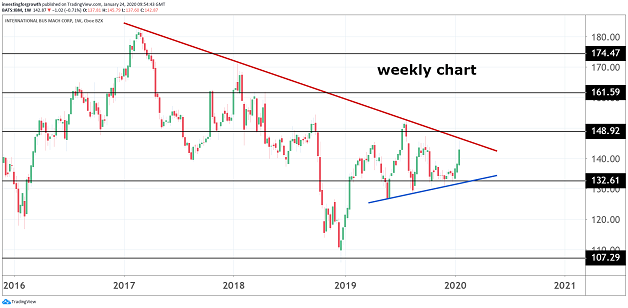Stockwatch: A genuine contrarian stock in an over-priced market
It’s raised guidance, is undergoing a shift to more dynamic sectors, and the shares appear cheap.
24th January 2020 11:11
by Edmond Jackson from interactive investor
It has already raised guidance and is undergoing a shift to more dynamic sectors, but the shares appear cheap, argues our companies analyst.

International Business Machines (NYSE:IBM) is relatively out-of-favour but offers limited downside risk due to strong cashflow and a 4.5% prospective yield. Upside prospects are driven by 20%-plus growth on its “cloud” side which is now a strategic priority.
Recalling my review of US stock picks last December, a current dilemma is around the number of high ratings linked to the Federal Reserve switching policy to renew stimulus from end-2018.
While market-leading stocks I advocated did post strong underlying results, their ratings benefited from a liquidity-fuelled rally. Some of the biggest 2019 rallies were in high-risk valuations that I wouldn’t touch: there are plenty examples in US stocks of companies worth tens if not hundreds of billions of dollars, that are yet to show profit.
That is fair enough perhaps for alert momentum traders and, if the US economy and stock market continue to strengthen, I also would not dispute that the likes of Google will dominate advertising for decades, and hence command a relative premium.
But there is “pricing for perfection”, and more. Who knows what global risks could erupt, whether Iran’s proxies instigate revenge attacks for general Qassem Soleimani’s assassination, or the coronavirus outbreak worsens.

Source: TradingView Past performance is not a guide to future performance
Macroeconomics offers a uniquely benign context
US macro is remarkably beneficial for equities: near full employment, a circa 5% budget deficit with the possibility of it improving, and long bond yields at around 3%.
It is interesting to recall a media interview last May when Warren Buffett quipped:
“Stocks are ridiculously cheap” albeit with the caveat “if you believe 3% on 30-year bonds makes sense.”
Meanwhile, his partner Charlie Munger said he could not have conceived of such benign factors “and if something’s impossible then it’s going to change...I don’t know in what way but I don’t think we can continue to have these variables in this relationship...”
That’s a manifestly conservative view, and it is also possible the benign context persists. Enough stock ratings, however, tell me to beware of over-crowded trades and favour unfashionable stocks showing genuine scope to improve.
Relatively attractive, established investment value
I believe IBM fits the bill. At around $143 a share, it offers investment grade criteria by way of a relatively attractive 12-months forward price/earnings (PE) of 10x versus a sector PE over 19x for technology services generally – and well below other cloud specialists.
Admittedly, IBM is late to the cloud party relative to the likes of Amazon (NASDAQ:AMZN) and Microsoft (NASDAQ:MSFT), but its $34 billion (£26 billion) cash acquisition of Red Hat introduces a lead-player founded in 1993.
Although I’ve drawn attention both to Amazon and Microsoft at much lower share prices, and would hold them for so long at the US market’s dynamics remain intact, with fresh money you are looking at 84x and 31x earnings respectively.
IBM’s forward price/sales ratio is 1.6x versus 2.9x for its sector, and a prospective dividend yield of 4.5%, based on a $6.5 per share dividend, compares to 2.6% for Qualcomm (NASDAQ:QCOM) and 2.9% for Cisco (NASDAQ:CSCO). And the payout looks secure given IBM’s current market capitalisation of $127 billion is around 10x projected free cashflow for 2020.
- 2020 could be transformational for this tech behemoth
- Is Tesla really worth $100bn?
- Want to buy and sell international shares? It’s easy to do. Here’s how
In very long-term chart context, IBM is still up massively from its lows at around $10 in the early 1990s, when it undertook a transformation from chiefly hardware to address opportunities in network computing, the shares testing $130 in spring 2000, then $213 in January 2013.
But over the last seven years, the trend has been broadly down, to a $113 low in the late 2018 markets’ plunge. Versus more exciting tech stories elsewhere, investors have broadly wearied of IBM which has been prone to over-promising and under-delivering, the market exacting a relatively high yield for the opportunity cost of holding its stock.
| International Business Machines Corp | ||||
|---|---|---|---|---|
| comparative financial results | ||||
| Three months ended | Year ended | |||
| 31-Dec | 31-Dec | 31-Dec | 31-Dec | |
| 2019 | 2018 | 2019 | 2018 | |
| Revenue $ million | ||||
| Cloud & cognitive software | 7,238 | 6,661 | 23,200 | 22,209 |
| Global business services | 4,243 | 4,269 | 16,634 | 16,595 |
| Global technology services | 6,949 | 7,299 | 27,361 | 29,146 |
| Systems | 3,042 | 2,621 | 7,604 | 8,034 |
| Global financing | 301 | 402 | 1,400 | 1,590 |
| Other | 4 | 507 | 948 | 2,018 |
| Total revenue | 21,777 | 21,760 | 77,147 | 79,591 |
| Gross profit $ million | 11,100 | 10,687 | 36,488 | 36,936 |
| margin % | ||||
| Cloud & cognitive software | 79.2 | 79.4 | 76.7 | 77.6 |
| Global business services | 27.5 | 27.8 | 27.7 | 26.8 |
| Global technology services | 35.2 | 34.9 | 34.8 | 34.4 |
| Systems | 56.0 | 50.8 | 53.1 | 49.8 |
| Global financing | 35.6 | 29.1 | 35.6 | 29.1 |
| Total gross profit margin % | 51.0 | 49.1 | 47.3 | 46.4 |
Source: historic Company REFS and company accounts
Red Hat is re-energising IBM’s prospects
While its latest fourth quarter 2019 results show just 0.1% growth in total revenue, overall cloud revenues surged 21% to $6.8 billion, accounting for 31% of total. Admittedly, the table shows global business services – 19.5% of total - effectively flat, and global technology services – 31.9% of total – easing nearly 5%, and IBM needs to show its next stock market reputation is not just a curate’s egg.
The overall 2019 results, simultaneously released, were a contrast in GAAP versus non-GAAP accounting. Total revenue eased 3.1% to $77.1 billion, though edged up 0.2% when adjusting for divested businesses and currency effects. Consolidated net income rose 8% to $9.4 billion with consolidated earnings per share (EPS) up 11% to $10.6.
However, on a non-GAAP basis, operating income fell 10% to $11.4 billion, and similarly non-GAAP EPS fell 7% to $12.8. More positively, the latter was guided up for the 2020 year to “at least” $13.35 and free cashflow from $11.9 billion in 2019 to $12.5 billion.
- 10 dividend shares for income hunters wanting payout growth
- ii Super 60 investments: Quality options for your portfolio, rigorously selected by our impartial experts
- Take control of your retirement planning with our award-winning, low-cost Self-Invested Personal Pension (SIPP)
Despite the lacklustre image for revenues, the fourth quarter 2019 results do buck a trend of falling for five consecutive quarters. They also marginally beat expectations by around 3%.
A concern I should point out is the backlog (i.e. work in progress) easing 3% at constant currency to $112.4 billion. IBM will need to substantiate in due course otherwise it sticks out versus guidance for modest growth. Management says, however, that it continued to invest during 2019, in higher-value growth areas of the industry, as shown in the table by advances in the total gross profit margin from 46.4% to 47.3%. Besides paying dividends, IBM also reduced its debt by $10 billion.
Scope for synergy between Red Hat and legacy IBM clients does look early-stage as yet, with ample scope to capitalise as IBM pursues its objective for the “hybrid cloud”. This is where clients use a mix of on-premises, private cloud and third party public cloud services – with orchestrating between the platforms.
Risk/reward profile tilts positively, barring a recession
So, my essential take on IBM is that doubts over existing service businesses are effectively priced in by way of the 4.5% prospective yield, backed by an ample and growing cashflow buffer. The Red Hat deal has also thoroughly transformed prospects and, while it will take time to materialise, it does offer a window to accumulate stock.
I also speculate that the board could replace IBM’s incumbent CEO – having served seven years - with Red Hat’s CEO, given cloud objectives are taking priority. A dilemma is the incumbent being linked to a perception of IBM “over-promising but under-delivering”. More positively, a change at the top would underline a break with the past. Just a possibility.
Raised guidance for 2020 may beget broker upgrades, though I suspect IBM is more a medium-term investment “buy” than a trade. Its chief risk would be a surprise slowdown in the global economy, perhaps if the coronavirus worsens or the US/Iran conflict flares up again. That said, in such circumstances IBM’s downside as a stock must be significantly less than those rated in the stratosphere.
Charts-wise, the stock is recovering out of the low $130 range in the fourth quarter of 2019, back to September levels in the low $140 area, albeit below last July’s high of $151. It is also well down on $180 nearly three years ago. So, chartists might want more evidence of a turnaround at IBM’s non-cloud business.
I speculate that synergies from Red Hat will broadly take the show forward, so, by the time of evidence, the stock will be higher. Buy.
Edmond Jackson is a freelance contributor and not a direct employee of interactive investor.
These articles are provided for information purposes only. Occasionally, an opinion about whether to buy or sell a specific investment may be provided by third parties. The content is not intended to be a personal recommendation to buy or sell any financial instrument or product, or to adopt any investment strategy as it is not provided based on an assessment of your investing knowledge and experience, your financial situation or your investment objectives. The value of your investments, and the income derived from them, may go down as well as up. You may not get back all the money that you invest. The investments referred to in this article may not be suitable for all investors, and if in doubt, an investor should seek advice from a qualified investment adviser.
Full performance can be found on the company or index summary page on the interactive investor website. Simply click on the company's or index name highlighted in the article.
Disclosure
We use a combination of fundamental and technical analysis in forming our view as to the valuation and prospects of an investment. Where relevant we have set out those particular matters we think are important in the above article, but further detail can be found here.
Please note that our article on this investment should not be considered to be a regular publication.
Details of all recommendations issued by ii during the previous 12-month period can be found here.
ii adheres to a strict code of conduct. Contributors may hold shares or have other interests in companies included in these portfolios, which could create a conflict of interests. Contributors intending to write about any financial instruments in which they have an interest are required to disclose such interest to ii and in the article itself. ii will at all times consider whether such interest impairs the objectivity of the recommendation.
In addition, individuals involved in the production of investment articles are subject to a personal account dealing restriction, which prevents them from placing a transaction in the specified instrument(s) for a period before and for five working days after such publication. This is to avoid personal interests conflicting with the interests of the recipients of those investment articles.